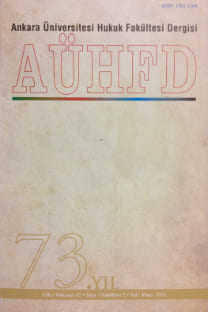The European Court of Human Rights Case Law on The Right to Information
Ülkemizde olduğu gibi dünyada da bilgi edinme hakkı son dönemde kabul edilen yeni haklardan birisidir. Açıklık ve hesap verilebilirliği sağlama ile bireyin devlet karşısında korunmasını amaçlayan bilgi edinme hakkı, normatif temelini ifade özgürlüğü içerisinde bulmaktadır. Ancak bu hak, Avrupa İnsan Hakları Mahkemesi önünde ifade özgürlüğü içerisinde yakın zamana dek tanınmamıştır. Bu çalışmada esas olarak, bu sorun irdelenmiş ve bilgi edinme hakkı ile bilgi alma hakkı arasındaki ayrım ortaya konulmaya çalışılmıştır. Bu bağlamda Avrupa İnsan Hakları Mahkemesi’nin özel hayatın ve aile hayatının korunmasını düzenleyen 8. maddesi ile ifade özgürlüğünü düzenleyen 10. maddesi mercek altına alınmıştır. Mahkeme’nin 10. maddeyi yorumlama şekli değerlendirilirken, ifade özgürlüğüne ilişkin benzer nitelikte bir hüküm içeren BM Medeni ve Siyasal Haklar Sözleşmesi’nin ilgili 19. maddesi de incelenmiş ve bu konuda BM İfade Özgürlüğü Özel Raportörü’nün görüşlerine de yer verilmiştir
Anahtar Kelimeler:
Bilgi edinme hakkı, bilgi alma hakkı, ifade özgürlüğü, özel hayatın gizliliği hakkı, bilgilendirilme hakkı
The European Court of Human Rights Case Law on The Right to Information
The right to information is one of the newly recognized rights throughout the world as well as in Turkey. The right to information, which aims to protect the individual against the state and to secure transparency and accountability, finds its normative basis in the freedom of expression. However up until now this right has not been recognized in the Court in the context of the freedom of expression. In this study, this point has been expanded to show the distinction between the right to information and the freedom to receive information. In this respect, Article 8 of the Convention dealing the right to respect for private and family life and Article 10 of the Convention on freedom of expression, have been scrutinized. Article 19 of the UN Covenant on Civil and Political Rights and the reports of the UN Special Rapporteur on Freedom of Expression have been analyzed in the context of the Court’s interpretation of Article 10
Keywords:
Right to information, freedom/right to receive information, freedom of expression, right to respect for private and family life, right to be informed,
___
- BANISAR, David (2004), Freedomofinfo.Global Survey: Freedom of Information and Access to Government Record Laws Around the World, http://www.freedominfo.org/survey.htm (20.01.2006).
- BAXTER, R.S. (1996), “Freedom of Information: Dispute Resolution Procedures”, European Public Law, Volume: 2, Issue: 4, (635-661).
- “Global Trends on The Right to Information: A Survey of South Asia”, www.article19.org/ docimages/ 116.htm (16.10.2004).
- HINS, Wouter; VOORHOOF, Dirk (2007), “Access to State-Held Information as a Fundamental Right under the European Convention on Human Rights”, European Constitutional Law Review,3, (114–126).
- HUSSAIN, Abid (1995,1996,1998,1999, 2000, 2003), Reports of the Special Rapporteur, E/ CN. 4/ 1995/32, E/ CN. 4/ 1996/ 39, E/ CN. 4/ 1997/31, E/ CN. 4/1999/ 64, E/CN. 4/ 2000/ 63, E/ CN. 4/ 2003/ 67, (http://www.ohchr.org/english/issues/opinion/index.htm), (08.11.2005).
- LOUCAIDES, G. Loukis (1995), “The Right to Information”, Essays on The Developing Law of Human Rights, Volume 39, (3-31).
- NOWAK, Manfred (1993), U. N. Covenant on Civil and Political Rights, CCPR Commentary, ( Germany: N. P. Engel Publisher).
- SEDLEY, Stephen (2000), “Information As a Human Right”, Freedom of Expression and Freedom of Information, (Edited by: BEATSON, Jack; CRIPPS, Yvonne), (USA: Oxford University Press), (239-248).
- www.article19.org
- www.bilgilenmehakki.org
- www.coe.int
- www.echr.coe.int
- www.freedominfo.org
- ISSN: 1301-1308
- Yayın Aralığı: Yılda 4 Sayı
- Başlangıç: 1943
- Yayıncı: Ankara Üniversitesi Hukuk Fakültesi
Sayıdaki Diğer Makaleler
United Nations Convention on Law of the Sea and Protection of the Marine Environment
Lapse of Time in Insurance Law for Extra-Payments’ Payback
The European Court of Human Rights Case Law on The Right to Information
RES IUDICATA’NIN TÜRKÇESĐ ÜZERİNE
Is the Crime of Abusing Bank or Credit Cards A Complex Crime?
